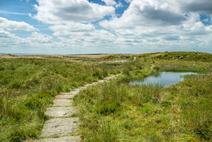Moors for the Future Partnership welcomes the inclusion of peatlands in Defra’s 25 Year Environment Plan which was released today. The proposal announces the intention to deliver a new ambitious framework for peat restoration in England.
The Partnership has been working since 2003 to protect the most degraded peatland landscape in Europe. It has transformed vast areas in the Peak District National Park and South Pennines. Bare black peat has become lush and green, the first step in returning these precious places to a healthy condition.

These peat moorlands at the heart of the country contain rare blanket bogs. The Peak District is England’s only home to the shy and elusive mountain hare. The wild habitat is a summer home to the curlew, which breeds in these upland areas. This beautiful bird is a globally threatened species. The South Pennines Special Area for Conservation is a source of drinking water for millions of people, stores carbon, and can help reduce the risk of flooding.
Moors for the Future Partnership’s Head of Programme Delivery Chris Dean, who attended the launch of the 25 Year Plan in London said:
“We welcome the announcement of Defra’s long-term commitment to protecting peatlands. Our partners have been working together to restore the landscapes of the Peak District and South Pennines for almost 15 years. We have achieved a lot in this time by putting these landscapes on a road to recovery, but our job is not finished. A long-term approach is essential to ensure that future generations can continue to enjoy these treasured landscapes.”
The Peak District National Park Authority is the lead partner in this innovative partnership. Partners include the Environment Agency, National Trust, RSPB, Severn Trent Water, United Utilities, Yorkshire Water, and Pennine Prospects. Natural England and representatives of the moorland owner and farming community provide advice.
The Partnership runs a programme of work funded by the EU Life Programme, Natural England, Heritage Lottery Fund and others. A monitoring programme provides evidence of the effectiveness of the innovative conservation techniques. This is backed up by creative communications that inspire people to care for these special places. It has recently submitted a £4.8 million application to Defra’s Peatland Restoration Fund to extend its work. The outcome is expected at the end of January.
Clifton Bain, Director of the UK Peatland Programme for the International Union for the Conservation of Nature said:
“Defra has signalled a new era for peatlands with its long term commitment to their protection in today’s 25 Year Environment Plan. The IUCN UK Peatland Programme has long highlighted the public services provided by healthy peatlands such as clean drinking water, climate change and flood mitigation, and welcomes the recognition of these from UK Government. Investment in conserving and repairing our peatlands and the people who manage them is the right and most cost-effective way forward, with the 25 Year Environment Plan bringing good news and reassurance to farmers, conservationists and society as a whole by recognising their important benefits.”
“We will work closely with government to ensure that delivery of this plan results in positive outcomes for peatlands, those that manage them and all of us that rely on them. The soon to be launched UK Peatland Strategy will help coordinate efforts across UK peatlands and set us as one of the world leaders in the global efforts to save our peatlands.”
The 25 year Environment Plan is available to read online.
Note – the photo on the front cover is the view along the Peak District National Park’s Great Ridge. The British Mountaineering Council’s Mend our Mountains Campaign is fundraising to repair eroded sections of this footpath.